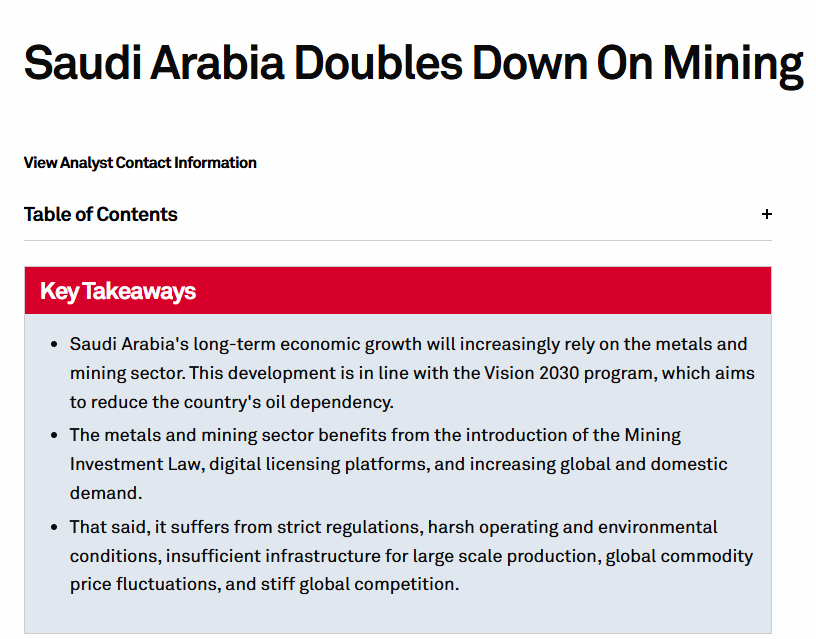






S&P Global recently released a report stating that metals and mining will play an increasingly important role in Saudi Arabia's future economic growth, a trend highly aligned with its "Vision 2030" strategic direction, with the core goal of reducing reliance on the oil economy.

Saudi Arabia is rich in metal and mineral resources, with metals such as copper, nickel, and lithium being critical raw materials for the energy transition, while phosphate minerals are of significant importance for food security.
Currently, the mining sector accounts for about 1.5% of Saudi Arabia's GDP. The report suggests that the Saudi government aims to increase the economic contribution of mining from $17 billion in 2024 to $75 billion by 2030.
The report points out that the Saudi government continues to introduce relevant policies, strengthening the institutional guarantees for industry development; at the same time, through state-led mega-projects and infrastructure construction, it is expected to enhance the resilience of domestic metal and mining enterprises, alleviate cost pressures, and improve their credit status.
Nevertheless, the report states that Saudi Arabia's mining and metal industries still face numerous challenges, including the complexity of regulatory and natural environments, the need for infrastructure construction, global commodity price fluctuations, and intense international competition.
Industrial growth will boost domestic metal demand.
The report believes that the expansion of Saudi Arabia's domestic industry is the core factor driving metal demand.
"We expect that with the continued advancement of investments under the Vision 2030 plan, as well as the increase in construction, logistics, and domestic manufacturing activities, Saudi Arabia's GDP will achieve an average annual growth rate of about 4% from 2025 to 2028," the report said.
The report indicates that based on the "Vision 2030" plan, the Saudi government plans to invest $40 billion annually through the Saudi Public Investment Fund (PIF) for infrastructure construction, real estate, and mega-projects such as NEOM and Diriyah Gate.
In addition, the report mentions that the Saudi government has invested nearly 29 billion riyals (approximately $7.7 billion) in phosphate mining and related logistics and service projects, while planning to invest $100 billion by 2035 to develop domestic critical mineral resources.
According to data from the General Authority for Statistics (GASTAT), the import cost of metal products in Saudi Arabia in 2024 is estimated to be between $20 billion and $24 billion.
The report states that in the long term, these measures will help boost domestic metal demand, reduce reliance on imports, and enhance the overall operational efficiency of the industry. Against the backdrop of continuously growing global demand for base metals and critical minerals, Saudi Arabia's metal and mining industry is expected to strengthen its supply capability in the international market.
However, the report also points out that the long-term development of the industry still depends on a more clear and predictable regulatory environment, especially in terms of international cooperation, contract transparency, and foreign investment in the local market, where Saudi Arabia needs continuous optimization to enhance the participation and confidence of international investors.
For queries, please contact Lemon Zhao at lemonzhao@smm.cn
For more information on how to access our research reports, please email service.en@smm.cn